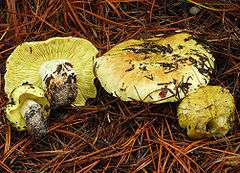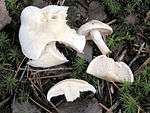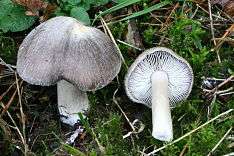Tricholoma
| Tricholoma | |
|---|---|
 | |
| Tricholoma flavovirens | |
| Scientific classification | |
| Kingdom: | Fungi |
| Division: | Basidiomycota |
| Class: | Agaricomycetes |
| Order: | Agaricales |
| Family: | Tricholomataceae |
| Genus: | Tricholoma Fries |
| Type species | |
| Tricholoma equestre (L.) P.Kumm. | |
Tricholoma is a genus of fungus that contains a large number of fairly fleshy white-spored gilled mushrooms which are found worldwide generally growing in woodlands. These are ectomycorrhizal fungi, existing in a symbiotic relationship with various species of coniferous or broad-leaved trees. The generic name derives from the Greek trichos (τριχος) meaning hair and loma (λωμα) meaning fringe or border,[1] although only a few species (such as T. vaccinum) have shaggy caps which fit this description.
Some well-known species are the East Asian Tricholoma matsutake, also known as "matsutake" or songi, and the North American species Tricholoma magnivelare, also known as "ponderosa mushroom", "American matsutake", or "Pine mushroom". Some are safe to eat, yet there are a few poisonous members, such as T. pardinum, T. tigrinum and T. equestre.
Many species originally described within Tricholoma have since been moved to other genera. These include the Wood blewit (Clitocybe nuda), previously Tricholoma nudum, blewit (Clitocybe saeva), previously Tricholoma personatum, and St George's mushroom (Calocybe gambosa) previously Tricholoma gambosum.
Species list





- Tricholoma acerbum – bitter knight
- Tricholoma aestuans
- Tricholoma albobrunneum
- Tricholoma album – white knight
- Tricholoma argyraceum
- Tricholoma atrosquamosum – dark-scaled knight
- Tricholoma auratum – golden Tricholoma
- Tricholoma bakamatsutake
- Tricholoma columbetta – dove-coloured Tricholoma
- Tricholoma equestre (previously T. flavovirens) – Man-on-Horseback
- Tricholoma fulvum
- Tricholoma huronense
- Tricholoma imbricatum – matt knight-cap
- Tricholoma inamoenum
- Tricholoma magnivelare – pine mushroom, American matsutake
- Tricholoma matsutake – matsutake
- Tricholoma mutabile
- Tricholoma myomyces
- Tricholoma nigrum
- Tricholoma orirubens
- Tricholoma pardinum
- Tricholoma pessundatum
- Tricholoma populinum
- Tricholoma portentosum
- Tricholoma resplendens
- Tricholoma saponaceum – soap-scented toadstool
- Tricholoma scalpturatum
- Tricholoma sejunctum
- Tricholoma squarrulosum
- Tricholoma sulphureum – sulphur Tricholoma, gas agaric
- Tricholoma terreum (= T. myomyces) – grey knight-cap
- Tricholoma tigrinum
- Tricholoma ustale – burnt knight
- Tricholoma ustaloides
- Tricholoma vaccinum – scaly Tricholoma, scaly knight
- Tricholoma venenatum
- Tricholoma virgatum – streaked Tricholoma, ashen knight
- Tricholoma zangii
See also
References
| Wikimedia Commons has media related to Tricholoma. |
- Marcel Bon : The Mushrooms and Toadstools of Britain and North-western Europe (Hodder & Stoughton 1987). ISBN 0-340-39935-X
- Régis Courtecuisse, Bernard Duhem : Guide des champignons de France et d'Europe (Delachaux & Niestlé, 1994-2000). ISBN 2-603-00953-2
External links
- Mushroom Expert – The Genus Tricholoma
- Mykoweb profile of T. magnivelare
- MYCOLOGY/bionet.mycology Archives